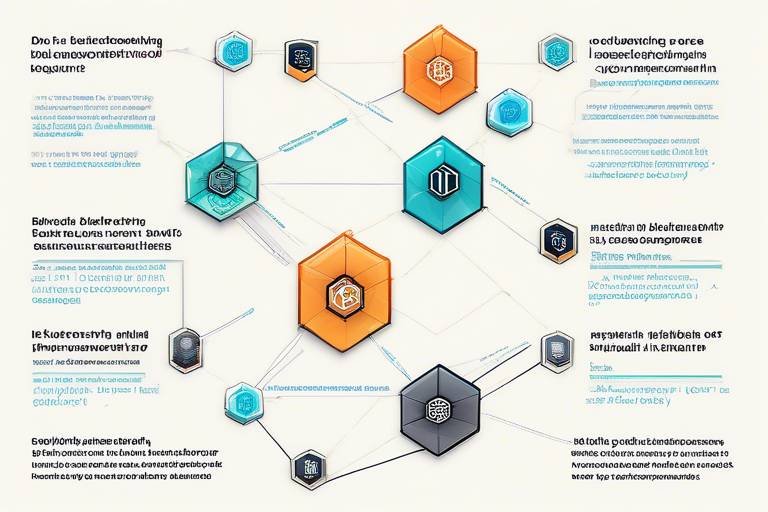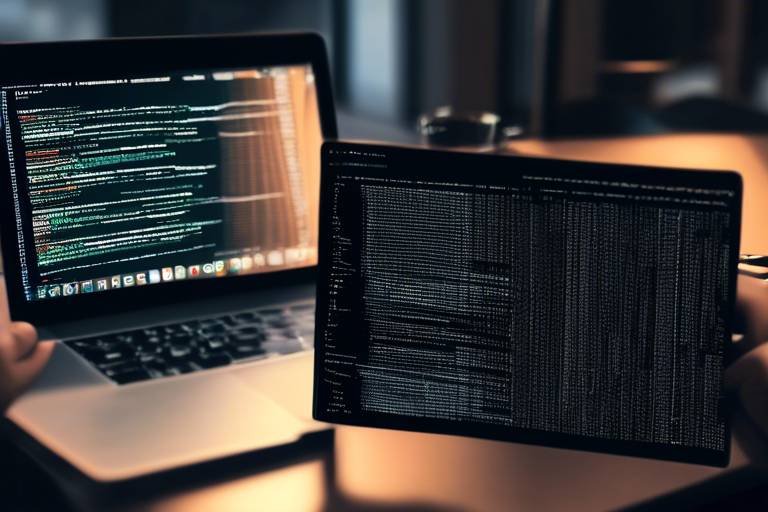The Role of Blockchain in Improving Public Safety
In recent years, the conversation around public safety has evolved significantly, especially with the advent of new technologies. One such technology that is making waves is blockchain. You might be wondering, how can a technology primarily associated with cryptocurrencies enhance public safety? Well, the answer lies in its core principles: transparency, data integrity, and efficient communication. Imagine a world where emergency services can access real-time data without the fear of tampering or misinformation. Sounds appealing, right? This article dives deep into how blockchain can revolutionize public safety by providing a secure and reliable framework for various stakeholders, including law enforcement, emergency responders, and the communities they serve.
Before we delve into the specifics of how blockchain can enhance public safety, let's take a moment to understand what blockchain is. At its core, blockchain is a decentralized digital ledger that records transactions across multiple computers. This decentralization means that no single entity has control over the entire network, which significantly reduces the risk of fraud and manipulation. Each transaction is stored in a block and linked to the previous one, forming a chain. This structure not only ensures that all data is secure but also makes it nearly impossible to alter past records without consensus from the network. Think of it as a digital fortress where information is locked away, accessible only to those with the right keys.
One of the standout features of blockchain is its ability to provide immutable records. In the realm of public safety, this is crucial. Imagine a scenario where a criminal record is altered or an incident report is falsified. The implications could be disastrous, leading to wrongful arrests or even the escape of dangerous individuals. With blockchain, once data is entered, it cannot be changed or deleted, ensuring that all records related to criminal activities, emergency responses, and law enforcement actions are accurate and trustworthy. This level of data integrity is like having a safety net that catches any attempts to manipulate the truth.
To better understand the practical applications of blockchain in law enforcement, let's look at some real-world examples. Various police departments across the globe have started implementing blockchain for different purposes. For instance, the city of Dubai has launched a blockchain-based platform for managing police records. This system not only improves data handling but also enhances evidence management and inter-agency collaboration. By using blockchain, agencies can share information securely and efficiently, leading to more coordinated and effective responses to criminal activities.
One of the most significant challenges in law enforcement is maintaining the integrity of evidence. Blockchain can streamline the chain of custody for evidence, ensuring that all records are secure, traceable, and tamper-proof. Imagine a scenario where every piece of evidence collected at a crime scene is logged into a blockchain. Each time the evidence is accessed, a new entry is created, documenting who accessed it and when. This creates a transparent and secure trail that can withstand scrutiny in court, ultimately enhancing the integrity of legal proceedings.
Another area where blockchain shines is in facilitating better communication and data sharing between different law enforcement agencies. Traditionally, these agencies often work in silos, leading to fragmented information and delayed responses. With blockchain, agencies can access a shared, secure database that allows for real-time updates and collaboration. This means that if one agency gathers crucial information about a suspect, it can be instantly shared with others, leading to more coordinated and effective responses to criminal activities. It’s like having a well-oiled machine where every part works seamlessly together.
When it comes to emergencies, every second counts. Blockchain can improve emergency response times by providing first responders with real-time access to crucial data. For instance, if a natural disaster strikes, emergency services can quickly access information about affected areas, available resources, and even the status of hospitals. This enhanced coordination among first responders, hospitals, and emergency services means that help can be dispatched more effectively, ultimately saving lives. Think of it as upgrading from a flip phone to a smartphone; the capabilities and efficiency are exponentially better.
In addition to improving operational efficiency, blockchain fosters greater transparency in public safety operations. Citizens can access real-time data and reports, allowing them to stay informed about crime rates, emergency responses, and other crucial safety information. This transparency can help build trust between communities and law enforcement agencies. Imagine a community where residents feel empowered to report incidents and participate in safety initiatives, knowing that their voices are heard and valued. Blockchain can turn this vision into reality.
Blockchain technology can empower citizens by providing them with access to crucial safety information. This not only encourages active participation in community safety initiatives but also fosters a sense of responsibility and ownership among residents. When citizens are informed and engaged, they are more likely to collaborate with law enforcement, leading to safer communities. It’s like having a neighborhood watch where everyone is in the loop and working together towards a common goal.
While the benefits of blockchain in public safety are compelling, it’s essential to acknowledge the potential challenges and limitations. Technical hurdles, such as the need for robust infrastructure and cybersecurity measures, can pose significant obstacles to implementation. Additionally, regulatory concerns and the need for widespread adoption among stakeholders can slow progress. However, with careful planning and collaboration, these challenges can be addressed, paving the way for a safer and more transparent future.
- What is blockchain technology? – Blockchain is a decentralized digital ledger that records transactions across multiple computers, ensuring security and data integrity.
- How does blockchain enhance public safety? – By providing immutable records, improving evidence management, and facilitating better communication among agencies.
- What are the challenges of implementing blockchain in public safety? – Technical hurdles, regulatory concerns, and the need for widespread adoption are some of the challenges faced.

Understanding Blockchain Technology
Blockchain technology is often described as a digital ledger that records transactions across many computers in such a way that the registered transactions cannot be altered retroactively. This decentralized nature is one of its most powerful features, as it eliminates the need for a central authority, thereby reducing the risk of fraud and manipulation. Imagine a notebook that everyone can see but no one can erase or change; that’s essentially what blockchain does for data integrity.
At its core, blockchain is made up of several fundamental components that work together to create a secure and trustworthy environment. These components include:
- Blocks: Each block contains a list of transactions and is linked to the previous block, forming a chain.
- Decentralization: Unlike traditional databases, which are controlled by a single entity, blockchain operates on a peer-to-peer network, ensuring that no single party has control over the entire chain.
- Consensus Mechanisms: These are protocols that consider a transaction as valid only when a majority of participants in the network agree on it. This could be through methods like Proof of Work or Proof of Stake.
- Cryptography: Blockchain uses cryptographic techniques to secure data, making it nearly impossible to alter information without detection.
So, how does this all tie into public safety? Well, by leveraging the strengths of blockchain, public safety agencies can enhance their operations significantly. For instance, the immutable nature of blockchain records means that once data is entered, it cannot be tampered with. This is crucial for maintaining accurate records related to criminal activities, incident reports, and emergency responses. Imagine if every police report filed was stored in a way that no one could change it after the fact; it would not only streamline the legal processes but also build a foundation of trust between the community and law enforcement.
Furthermore, the transparency offered by blockchain technology allows all stakeholders, including law enforcement, emergency services, and even the public, to access real-time data. This open access can lead to better informed decision-making and quicker responses in critical situations. When everyone is on the same page, it’s like a well-rehearsed dance—each participant knows their role, and the performance is seamless.
As we delve deeper into the applications of blockchain in public safety, it's essential to appreciate how this technology can transform the landscape. From improving evidence management to optimizing emergency response times, the potential is vast. The next sections will explore these applications in detail, highlighting real-world case studies and the benefits they bring to public safety.

Enhancing Data Integrity
In today's digital age, the integrity of data is paramount, especially when it comes to public safety. Imagine a world where every piece of information related to criminal activities, incident reports, and emergency responses is not only accurate but also immutable. This is where blockchain technology shines. By providing a decentralized and transparent system, blockchain ensures that once data is recorded, it cannot be altered or deleted without a trace. This characteristic is crucial for maintaining the integrity of information that law enforcement and emergency responders rely on.
Let’s break it down further. When we talk about data integrity in public safety, we are essentially referring to the accuracy and reliability of data. In a traditional system, data can be easily manipulated or falsified, often leading to dire consequences. For instance, if a criminal record is altered, it could result in wrongful arrests or ineffective law enforcement strategies. Blockchain addresses this by creating a secure digital ledger that records each transaction or piece of data in a way that is verifiable and permanent. Each entry is linked to the previous one, forming a chain of blocks that is nearly impossible to tamper with.
Furthermore, the benefits extend beyond just protecting data from manipulation. The transparency provided by blockchain allows for greater accountability among various stakeholders in the public safety sector. For example, if a police department logs an incident report, that entry is visible to authorized personnel across different agencies, ensuring that everyone has access to the same information. This level of transparency fosters trust among law enforcement agencies and the communities they serve.
To illustrate the impact of blockchain on data integrity, consider the following table:
| Aspect | Traditional System | Blockchain System |
|---|---|---|
| Data Manipulation | Possible | Nearly Impossible |
| Data Access | Limited to specific departments | Accessible to authorized users across agencies |
| Accountability | Often questioned | Enhanced through transparency |
| Audit Trails | Manual and prone to errors | Automatic and tamper-proof |
As you can see, the advantages of using blockchain in public safety are significant. Not only does it improve the reliability of data, but it also enhances the overall efficiency of law enforcement operations. With fewer errors and a more trustworthy system, agencies can focus on what truly matters—keeping the community safe. In essence, blockchain acts as a guardian of data integrity, ensuring that the information used in public safety decisions is both accurate and trustworthy.
In conclusion, enhancing data integrity through blockchain technology is not just about securing information; it's about building a foundation of trust and accountability in public safety. As we continue to explore the potential of blockchain, it's clear that its role in creating a safer society is just beginning to unfold.

Case Studies in Law Enforcement
When it comes to the practical application of blockchain technology in law enforcement, several case studies stand out, showcasing the profound impact this innovation can have on public safety. One of the most notable examples is the implementation of blockchain systems by the city of Dubai, which aims to create a fully paperless government by 2021. This initiative includes the use of blockchain for various law enforcement activities, such as managing police records and evidence. The Dubai Police Department has reported a significant reduction in paperwork and an increase in the efficiency of their operations. Imagine a world where officers can access real-time data about criminal activities right from their mobile devices, all thanks to blockchain!
Another compelling case study is in the state of Wyoming, USA. The local government has embraced blockchain technology to enhance the integrity of its public records. By utilizing a blockchain system for criminal records, the Wyoming Department of Criminal Investigation has created a tamper-proof digital ledger that ensures the accuracy and reliability of information. This not only helps in maintaining the integrity of criminal records but also fosters trust among citizens who rely on these records for various purposes, such as employment background checks.
In addition to these examples, the city of Zug in Switzerland, often referred to as "Crypto Valley," has implemented a blockchain-based identity verification system for its residents. This system allows law enforcement to quickly verify identities during traffic stops or other interactions. The benefits are twofold: not only does it streamline the process, but it also enhances the safety of both officers and citizens by reducing the time spent on identity checks.
Moreover, in the realm of evidence management, the Canadian company Everledger has developed a blockchain solution that tracks the provenance of diamonds to prevent conflict diamonds from entering the market. While this may seem tangential to law enforcement, the implications are significant. By ensuring that only ethically sourced diamonds are traded, law enforcement agencies can more effectively combat organized crime and fraud linked to diamond trafficking.
These case studies illustrate that blockchain technology is not just a theoretical concept but a practical tool that can transform law enforcement operations. By improving data handling and evidence management, law enforcement agencies can collaborate more effectively, ultimately leading to enhanced public safety. The beauty of blockchain lies in its decentralization and transparency, which are crucial for building trust between law enforcement and the communities they serve.
As we look to the future, it’s clear that the adoption of blockchain in law enforcement is not merely a trend; it’s a necessary evolution in how we approach public safety. The possibilities are endless, and the successes already seen in various jurisdictions provide a roadmap for others to follow. Will your city be next to embrace this revolutionary technology?
- What is blockchain technology? Blockchain is a decentralized ledger technology that allows for secure and transparent record-keeping.
- How does blockchain improve public safety? By enhancing data integrity, improving evidence management, and facilitating better communication among law enforcement agencies.
- Are there any challenges to implementing blockchain in law enforcement? Yes, there are technical hurdles, regulatory concerns, and the need for widespread adoption among stakeholders.

Improving Evidence Management
In the world of law enforcement, managing evidence is akin to holding the keys to justice. Imagine a scenario where a crucial piece of evidence goes missing or is tampered with. The implications can be devastating, not just for the case at hand but for the entire judicial system. This is where blockchain technology steps in as a game changer, offering a robust solution to the age-old problem of evidence management.
At its core, blockchain provides a decentralized and immutable ledger that ensures every piece of evidence is accounted for, from the moment it is collected until it is presented in court. Each transaction involving evidence—be it collection, storage, or transfer—gets recorded as a unique, time-stamped entry on the blockchain. This means that every action taken regarding the evidence is transparent and verifiable, drastically reducing the chances of tampering or loss.
For instance, consider the traditional methods of evidence management. They often rely on physical documentation and centralized databases, which can be vulnerable to human error or malicious intent. With blockchain, the chain of custody is not only preserved but also made traceable. Each time evidence is accessed or moved, a new entry is created, providing a complete history that can be audited at any time. This level of transparency is crucial for maintaining the integrity of legal proceedings and ensuring that justice is served.
Moreover, blockchain technology can facilitate the integration of various stakeholders involved in the evidence management process. Law enforcement agencies, forensic teams, and legal representatives can all access the same secure platform, ensuring that everyone is on the same page. Imagine a police officer collecting evidence at a crime scene; with a simple scan of a QR code, that evidence can be logged onto the blockchain, instantly updating all relevant parties. This not only saves time but also enhances collaboration, leading to more effective investigations.
To illustrate the potential of blockchain in evidence management, consider the following table that outlines the key benefits:
| Benefits | Description |
|---|---|
| Immutability | Once recorded, evidence data cannot be altered or deleted, ensuring authenticity. |
| Transparency | All stakeholders can view the evidence history, promoting accountability. |
| Efficiency | Streamlined processes reduce the time spent on evidence handling and tracking. |
| Collaboration | Improved communication between agencies leads to more coordinated investigations. |
In summary, improving evidence management through blockchain technology not only enhances the integrity of the judicial process but also instills confidence in the public that their justice system is reliable and fair. As more law enforcement agencies recognize the benefits of this innovative approach, we can expect to see a significant shift in how evidence is handled, ultimately leading to more successful prosecutions and a safer society.
Q: How does blockchain ensure the integrity of evidence?
A: Blockchain creates an immutable record of all transactions related to evidence, making it nearly impossible to alter or tamper with the information.
Q: Can multiple agencies access the same evidence on the blockchain?
A: Yes, blockchain allows for secure access by multiple stakeholders, facilitating better collaboration and communication.
Q: What are the challenges of implementing blockchain in evidence management?
A: Challenges include the need for technical infrastructure, training for personnel, and regulatory compliance.

Inter-Agency Collaboration
In today's fast-paced world, where every second counts, the ability of law enforcement agencies to collaborate effectively can mean the difference between chaos and order. Blockchain technology is emerging as a powerful tool to facilitate this collaboration, creating a seamless flow of information between different agencies. Imagine a scenario where police departments, fire services, and emergency medical teams can access a unified platform that provides real-time updates and data sharing. This is not just a dream; it's becoming a reality through the implementation of blockchain.
One of the most significant advantages of blockchain is its decentralized nature. Unlike traditional systems that rely on a central authority, blockchain allows multiple agencies to share information without the need for a middleman. This means that when one agency updates a record—be it an incident report or a criminal record—other agencies can instantly access that information, ensuring everyone is on the same page. This real-time data sharing is crucial during emergencies, where timely decisions can save lives.
Moreover, blockchain enhances trust among agencies. With its immutable ledger, any data entered into the blockchain cannot be altered or deleted. This feature is particularly important when it comes to sensitive information, such as evidence collected during investigations. Agencies can collaborate with confidence, knowing that the data they are sharing is accurate and secure. For instance, when a crime occurs that involves multiple jurisdictions, having a shared, tamper-proof record can streamline investigations and lead to quicker resolutions.
To illustrate the impact of blockchain on inter-agency collaboration, consider the following table that highlights key benefits:
| Benefit | Description |
|---|---|
| Real-Time Data Access | Agencies can access updated information instantly, reducing response times. |
| Enhanced Trust | Immutable records ensure data integrity, fostering confidence among agencies. |
| Streamlined Processes | Collaborative efforts become more efficient, minimizing bureaucratic delays. |
| Improved Accountability | All actions are recorded, making it easier to track decisions and outcomes. |
In addition to these benefits, blockchain can also help identify patterns and trends across different jurisdictions. By analyzing data from various agencies, law enforcement can gain insights into criminal activities that might not be visible when data is siloed. For example, if several agencies report a rise in specific types of crimes, they can collaborate to develop targeted strategies to combat these issues collectively.
However, while the potential is immense, it’s essential to acknowledge that implementing blockchain for inter-agency collaboration is not without its challenges. Issues such as interoperability between different systems, data privacy concerns, and the need for comprehensive training and education on how to use blockchain effectively must be addressed. But with the right approach and commitment from all stakeholders, the future of inter-agency collaboration in public safety looks promising.
- What is blockchain technology? - Blockchain is a decentralized digital ledger that records transactions across many computers, ensuring that the information cannot be altered retroactively.
- How does blockchain improve inter-agency collaboration? - By providing real-time access to immutable data, blockchain allows different agencies to share information quickly and securely, enhancing trust and coordination.
- What are the challenges of implementing blockchain in public safety? - Challenges include technical integration, data privacy issues, and the need for training among personnel.
- Can blockchain help in emergency response? - Yes, blockchain can streamline communication and data sharing among first responders, leading to faster and more effective emergency responses.

Emergency Response Optimization
When it comes to emergency response, every second counts. Imagine a world where first responders can access real-time data at the touch of a button, drastically reducing response times and improving outcomes for those in need. This is where blockchain technology steps in, revolutionizing the way emergency services operate. By providing a secure, decentralized platform for data sharing, blockchain allows for seamless communication between various stakeholders, including first responders, hospitals, and emergency services.
One of the most significant benefits of blockchain in emergency response is its ability to offer real-time data access. For instance, when a 911 call is made, the information can be immediately recorded and shared across all relevant agencies. This means that as soon as the call is placed, responders can access critical details such as the nature of the emergency, location, and even the medical history of the caller if available. This level of accessibility can be the difference between life and death.
Furthermore, the integration of blockchain can streamline the coordination among various emergency services. In a typical scenario, multiple agencies might respond to a single incident, such as a natural disaster or a major accident. With blockchain, all parties involved can share updates and information in real time, ensuring that everyone is on the same page. This not only enhances the efficiency of the response but also fosters a sense of unity among the agencies involved, which is crucial during high-pressure situations.
Consider a recent case in which a major earthquake struck a populated area. Emergency services, including police, fire departments, and medical teams, were deployed. By utilizing blockchain technology, these agencies could efficiently share information about the most affected areas, available resources, and the status of ongoing rescue operations. As a result, they were able to prioritize their efforts and allocate resources more effectively, ultimately saving more lives.
Additionally, blockchain can help in maintaining a tamper-proof record of all communications and actions taken during an emergency response. This feature is vital for accountability and transparency, ensuring that all decisions made during a crisis can be traced back and reviewed if necessary. It builds trust not only among agencies but also with the public, who can have confidence that their safety is in reliable hands.
In summary, the optimization of emergency response through blockchain technology is not merely a futuristic concept; it is a practical solution that can significantly enhance the efficacy of public safety operations. By ensuring real-time data access, improving inter-agency coordination, and providing a secure record of actions taken, blockchain stands to transform the landscape of emergency services for the better.
- How does blockchain improve emergency response times? Blockchain provides real-time access to critical data, allowing first responders to make informed decisions quickly.
- What are the benefits of inter-agency communication through blockchain? It facilitates seamless sharing of information, ensuring coordinated responses during emergencies.
- Is blockchain technology secure for public safety applications? Yes, blockchain's decentralized nature and immutable records enhance data security and integrity.
- Can blockchain help build trust between communities and law enforcement? Absolutely, by promoting transparency and accountability in public safety operations.

Public Trust and Transparency
In today's world, where skepticism often clouds the relationship between communities and law enforcement, transparency has never been more crucial. Blockchain technology, with its inherent capabilities, offers a beacon of hope in enhancing public trust. Imagine a world where citizens can access real-time data about safety incidents, police activities, and community engagement initiatives without any gatekeeping. This is not just a dream; it’s a tangible reality that blockchain can help facilitate.
By leveraging blockchain, law enforcement agencies can provide an open ledger of information that is both secure and immutable. This means that once data is recorded, it cannot be altered or deleted, ensuring that the information remains trustworthy. For citizens, this transparency can foster a sense of security and empowerment, making them feel more involved in their community's safety. They can see how their local police are responding to incidents, the outcomes of investigations, and the allocation of resources in real-time.
Moreover, the implementation of blockchain can lead to a significant reduction in misinformation. When information is readily available on a public blockchain, it becomes much harder for rumors to spread unchecked. Citizens can verify facts directly from the source, which can dramatically reduce panic during emergencies. For example, if a natural disaster strikes, having immediate access to verified information about evacuation routes or available shelters can save lives and prevent chaos.
To illustrate the importance of public trust, consider the following points:
- Enhanced Accountability: With blockchain, every action taken by law enforcement can be traced back to its source, making it easier to hold individuals accountable for their actions.
- Community Engagement: Citizens can engage more with their local law enforcement when they feel informed and included in the safety processes.
- Reduction of Bias: Transparent data can help eliminate biases in policing, as decisions can be tracked and analyzed based on objective data rather than subjective opinions.
In conclusion, the integration of blockchain can significantly enhance public trust and transparency in law enforcement. By providing citizens with direct access to information, law enforcement agencies can build stronger relationships with the communities they serve. This not only leads to a safer environment but also fosters a culture of cooperation and mutual respect.
Q1: How does blockchain enhance transparency in law enforcement?
A1: Blockchain creates an immutable record of data that can be accessed by the public, ensuring that information related to police activities and community safety is transparent and trustworthy.
Q2: What are the benefits of increased public trust?
A2: Increased public trust can lead to better cooperation between communities and law enforcement, more effective crime prevention strategies, and an overall safer environment.
Q3: Are there any risks associated with using blockchain in public safety?
A3: While blockchain offers many benefits, challenges such as technical hurdles, data privacy concerns, and the need for widespread adoption among stakeholders must be addressed.

Citizen Engagement
In today's digital age, has taken on a new meaning, especially with the advent of blockchain technology. Imagine a world where citizens are not just passive recipients of information but active participants in their community's safety. Blockchain offers a unique opportunity for this kind of involvement. By providing transparent access to crucial safety information, residents can monitor local crime statistics, emergency response times, and even community safety initiatives in real-time. This level of transparency can significantly enhance the relationship between law enforcement and the community, fostering a sense of trust and cooperation.
Consider this: when citizens have access to reliable, real-time data, they become empowered to take action. Whether it's reporting suspicious activities or participating in neighborhood watch programs, informed citizens can make a tangible difference. For instance, if a community is aware of a spike in thefts in their area, they can organize themselves better to increase vigilance, thus potentially reducing crime rates. This proactive approach not only enhances public safety but also builds a tighter-knit community.
Moreover, blockchain facilitates the creation of decentralized platforms where citizens can voice their concerns and suggestions regarding local safety measures. Through these platforms, community members can collaborate with law enforcement to develop effective strategies tailored to their specific needs. This two-way communication is vital; it ensures that the voices of the community are heard and considered in decision-making processes. The result? A more engaged and informed populace that feels a sense of ownership over their safety.
However, while the potential for citizen engagement through blockchain is immense, it’s essential to recognize the challenges that come with it. Not everyone is tech-savvy, and there might be concerns regarding data privacy and security. To address these issues, law enforcement agencies must invest in educational programs that teach citizens how to use these technologies safely and effectively. Additionally, the development of user-friendly applications can bridge the gap for those who may feel intimidated by new technology.
In conclusion, blockchain technology not only enhances public safety but also empowers citizens to take an active role in their community. By fostering transparency and facilitating communication, blockchain can transform the way communities interact with law enforcement. As we move forward, it’s crucial to embrace these innovations and continue to explore how they can be leveraged to create safer, more engaged communities.
- What is blockchain technology? Blockchain is a decentralized digital ledger that records transactions across many computers. This ensures that the recorded transactions cannot be altered retroactively, providing a high level of security and trust.
- How can blockchain improve public safety? By providing immutable records and enhancing communication among various stakeholders, blockchain can improve data integrity, streamline evidence management, and facilitate better emergency response.
- What role do citizens play in blockchain initiatives? Citizens can engage actively by accessing real-time safety information, participating in community safety initiatives, and collaborating with law enforcement through decentralized platforms.
- What challenges exist in implementing blockchain for public safety? Challenges include technical hurdles, regulatory concerns, and the need for widespread adoption among stakeholders, including law enforcement and the community.

Challenges and Limitations
While blockchain technology holds tremendous potential for enhancing public safety, it is not without its . One of the primary hurdles is the technical complexity associated with implementing blockchain systems. Many law enforcement agencies may lack the necessary technical expertise to manage and maintain blockchain solutions effectively. This can lead to a reliance on third-party vendors, which may introduce additional risks and vulnerabilities.
Moreover, the integration of blockchain with existing systems can be a daunting task. Many agencies currently operate on legacy systems that may not be compatible with blockchain technology. This incompatibility can result in significant costs and resource allocation challenges, as agencies would need to invest in new infrastructure and training. The transition period can also create gaps in data management, potentially undermining the very improvements that blockchain aims to deliver.
Another significant concern is regulatory compliance. The legal landscape surrounding blockchain is still evolving, and many jurisdictions have yet to establish clear regulations governing its use in public safety. This uncertainty can deter agencies from adopting blockchain solutions, as they may fear potential legal repercussions or non-compliance with existing laws. Additionally, issues related to data privacy and security must be addressed, as blockchain systems often require the sharing of sensitive information among various stakeholders.
Furthermore, the need for widespread adoption among all stakeholders is crucial for blockchain's success in public safety. If only a few agencies implement blockchain while others do not, the potential benefits of improved communication and data sharing may be lost. This lack of uniformity can lead to fragmented systems, making it difficult to achieve the level of coordination necessary for effective public safety responses.
Lastly, there is a cultural resistance to change within many organizations. Law enforcement agencies often have established protocols and practices, and introducing a new technology like blockchain may be met with skepticism. Overcoming this resistance requires not only education and training but also a shift in mindset regarding the adoption of innovative technologies.
In summary, while the promise of blockchain in enhancing public safety is significant, it is essential to recognize and address these challenges. By doing so, agencies can pave the way for a more secure and efficient public safety framework that leverages the strengths of blockchain technology.
- What is blockchain technology? Blockchain is a decentralized digital ledger that records transactions across many computers securely and immutably.
- How can blockchain improve public safety? Blockchain enhances public safety by providing transparent, tamper-proof records that improve data integrity and facilitate better communication among agencies.
- What are the main challenges of implementing blockchain in public safety? The main challenges include technical complexity, regulatory compliance, the need for widespread adoption, and cultural resistance to change.
- Is blockchain secure? Yes, blockchain is considered secure due to its decentralized nature and cryptographic techniques that protect data from unauthorized access and tampering.
Frequently Asked Questions
- What is blockchain technology?
Blockchain technology is a decentralized digital ledger that records transactions across multiple computers. This ensures that the recorded information cannot be altered retroactively, providing a high level of security and trust. Think of it as a digital notebook that everyone can see but no one can erase or change!
- How does blockchain improve public safety?
Blockchain enhances public safety by increasing transparency and data integrity. It allows for secure and tamper-proof records of incidents, criminal activities, and emergency responses, making it much harder for anyone to manipulate crucial information. Imagine knowing that every piece of data is locked in a vault that no one can break into!
- Can blockchain help in law enforcement?
Absolutely! Law enforcement agencies can use blockchain for better evidence management and inter-agency collaboration. It streamlines the chain of custody for evidence, ensuring that records are secure and traceable, which is vital for legal proceedings. It’s like having a super-secure file cabinet that tracks every time someone opens it!
- How does blockchain optimize emergency response?
By providing real-time data access, blockchain can significantly improve emergency response times. It enhances coordination among first responders, hospitals, and other emergency services, ensuring that everyone is on the same page. Think of it as a high-tech communication system that keeps all hands on deck during a crisis!
- What role does transparency play in public safety?
Transparency is crucial in building trust between communities and law enforcement. With blockchain, citizens can access real-time data and reports about public safety operations, fostering a sense of involvement and trust. It’s like having a window into the workings of public safety, where everyone can see what’s happening!
- Are there challenges to implementing blockchain in public safety?
Yes, there are challenges, including technical hurdles, regulatory concerns, and the need for widespread adoption among stakeholders. Implementing a new technology like blockchain can be complex, much like trying to get everyone in a group project to agree on a single plan!
- How can citizens engage with blockchain technology for safety?
Citizens can engage by accessing crucial safety information provided through blockchain platforms. This empowers them to participate actively in community safety initiatives, creating a collaborative environment between the public and law enforcement. It’s like being part of a neighborhood watch that’s powered by cutting-edge technology!



















